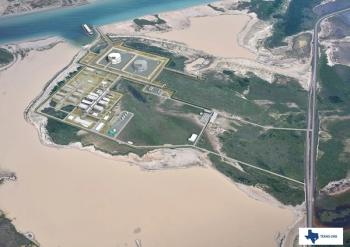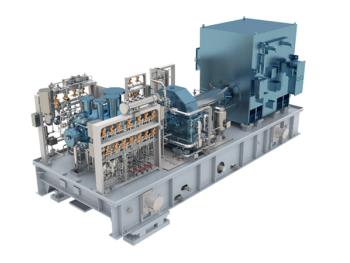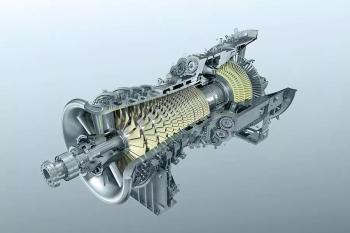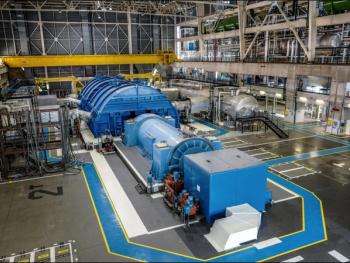
- September/October 2022
2022 TURBO EXPO
SPEAKERS STRESSED HYDROGEN, DECARBONIZATION, SUPERCRITICAL CO2, AND LNG
The Turbomachinery Expo took place again in 2022 for the first time since 2019. Rotterdam in the Netherlands hosted the event. About 2000 people attended around 1000 technical presentations as well as 16 panels, 38 tutorials, three special lectures, two plenary sessions, an exhibit hall, and a keynote – a lot to pack into one week.
Vendors such as Southwest Research Institute, Shell, Uniper, ETN Global, Air France KLM Group, Deltalinqs, Siemens Energy, and Rolls Royce covered a wide range of topics. Supercritical CO₂, hydrogen, and decarbonization were in the forefront. But they were balanced out by plenty of briefings on coatings, maintenance, gas turbine and compressor advances, liquefied natural gas (LNG), research on turbomachinery innovation, and more.
The week began with a keynote on the future of propulsion and power. A range of speakers offered their views on the energy transition and how it will impact aviation, power generation, and oil & gas.
Victor van der Chijs, Chairman of Deltalinqs, representing the logistics, port, and industrial companies in the port of Rotterdam, welcomed everyone to the city. He noted that The Netherlands obtains 55% of its energy demand from renewable sources and is actively engaged in building hydrogen infrastructure. Yet he emphasized the need to balance renewables with gas-fired generation.
Christer Björkqvist, Managing Director and founder of ETN Global, followed to present the overall theme of the keynote as the “Energy Trilemma.” This, he said, is all about balancing three things:
• Access and affordability
• Security of supply
• Environmental Sustainability.
He invited several speakers on stage to elaborate on this theme.
Priscilla Chandrasekaran, Global LNG Technology Innovation Manager at Shell Global Solutions International, covered the various synergies between LNG and hydrogen as well as what the decarbonization of LNG means in the real world. It requires the acceleration of the production of hydrogen-ready GTs. Options need to be available to retrofit such machines into existing plants as well as offering models for new facilities.
She noted the growing supply/demand gap. Current production levels need to double over the next two decades in order to keep pace with demand projections.
“We need to make the decarbonization of LNG simple and affordable,” she said. “Retrofits need to be accomplished without months of downtime or the need for complex fuel gas management systems.”
Dr. Thomas Thiemann, Senior Vice President, Siemens Energy, added that although countries such as Germany had achieved rates of around 50% renewable generation on the grid, the fact remains that there are long periods without wind and sun in Europe. He championed batteries and pumped storage as ways to increase the value of renewables by storing energy. Batteries were characterized as providing short-term power for the minutes and the hours when wind or solar are offline. But they are not a viable solution when the energy shortfall lasts for days. That is where LNG and gas-power generation come into their own. But these systems also need to become hydrogen ready.
Pedro Lopez Estebaranz, COO, Uniper and Michael Grootenboer, Senior Vice President Engine Products for the Air France KLM Group, continued the theme of the energy trilemma, wrapping up the opening morning.
SESSIONS GALORE
As the foremost technical and research-oriented show in the world of turbomachinery, the Turbo Expo always serves up a wide variety of sessions. Here are just a few of the highlights:
Southwest Research Institute (SwRI) delivered a tutorial as an introduction to supercritical CO₂ (sCO₂). There has been much interest on sCO₂ for the past decade. Ten years ago, it was the talk of the show, but progress since that time has been slow. The session provided a good grounding of specific areas related to sCO₂ power cycles, demonstration test facilities, heat exchangers, turbomachinery, materials, and the various fluid properties of CO₂ and CO₂ mixtures.
Presenters mentioned sCO₂’s role in the decarbonization of the power generation sector, transportation, and industrialization processes. But there are practical challenges to overcome. Current research is addressing these challenges to bring the technology to commercial fruition.
A later panel addressed the digitalization journey of the propulsion and power industries. It will require large investments as well as cultural changes to realize the promise of digitalization: improvements in workforce efficiency, increased pace in design, manufacture and test, and greater interconnectivity driven by more compute power, modern IT hardware, and faster digital networks. These gains, in turn, require an understanding of the data needs of the digital age. A vast amount of data already exists in organizations. It needs to be better managed and utilized to support data-driven decisions and to create a data-centric culture. Challenges abound in areas such as data gathering, storing, handling, and interpretation of data.
Another tutorial by a speaker from NASA Glenn Research Center delved into environmental barrier coatings (EBCs) for gas turbine applications. The implementation of ceramic matrix composites (CMCs) in the hot section of gas turbines, for example, can lead to increased thermal and propulsive efficiency as a result of their high temperature capability, high strength-to-weight ratio, and toughness. However, problems need to be overcome.
The SiO₂ scale responsible for oxidation resistance at high temperature for SiC-based CMCs, for example, is subject to rapid volatilization by water vapor generated as a byproduct during the combustion process. Subsequently, enhanced oxidation and rapid surface recession occurs resulting in decreased structural integrity and reduced lifetime. To combat the volatilization and surface recession due to water vapor, EBCs have been developed to protect CMC components. EBCs are considered an enabling technology for SiC-based CMCs as they are critical for durability, and longer life. The tutorial encompassed an understanding of the environmental degradation mechanisms of SiC-based ceramics, a history of EBC development, an introduction to EBC failure modes (such as oxidation, recession, thermomechanical fatigue, degradation by calcium-magnesium-aluminosilicate deposits, solid particle erosion, and foreign object damage), an introducion to environmental durability test methods and characterization of EBCs, and future directions and challenges.
Hydrogen, of course, came in for attention at the show. One of the top hydrogen-related sessions considered what would be needed to develop and deploy hydrogen technologies for the generation electricity and the powering of aviation. Panelists noted the present state-of-the-art for hydrogen generation and transport, energy storage, and how hydrogen can best be deployed for power and propulsion. Additionally, they delved into the challenges in converting current and installing new infrastructure for handling, transporting, and storing hydrogen.
Sarah Hopkin, Hydrogen Researcher at Shell Oil, emphasized that for hydrogen to succeed, pipelines were needed that could contain hydrogen safely, as well as carbon capture, utilization, and storage (CCUS). There are already around 5000 km of hydrogen pipelines in the world, mostly in the US and Europe. While the industry has been piping hydrogen for a long time, there is little experience in repurposing existing pipelines for hydrogen. Part of the problem is that the presence of hydrogen affects the fatigue properties of steel.
On the same pane, Tim Allison, Machinery Department Director, Southwest Research Institute, focused on the machinery needed for evolving energy storage applications. He began by stating that California managed to power its entire grid by renewables for a brief period recently. But during the late afternoon and evening, non-renewable sources must be available to meet any supply shortfall. Further, the existing turbomachinery supply chain is ideally suited to take on the challenges of energy storage. Turbomachinery, he said, decouples power from duration. Machinery-based systems can be utilized in pumped hydro, compressed air energy storage (CAES), liquid air energy storage, and other applications to lower the cost of long-duration energy storage.
Articles in this issue
about 3 years ago
COMPRESSOR MAPSabout 3 years ago
DUAL DRIVE COMPRESSORSabout 3 years ago
YASKAWA ENVIRONMENTAL ENERGY / THE SWITCHabout 3 years ago
MYTH: AN ASME PTC-10 TYPE 1 IS BETTER THAN A TYPE 2 TESTabout 3 years ago
SUPERCRITICAL CO2about 3 years ago
LONG-DURATION STORAGEover 3 years ago
TURBOMACHINERY CONTROLS GO HIGH TECHNewsletter
Power your knowledge with the latest in turbine technology, engineering advances, and energy solutions—subscribe to Turbomachinery International today.




